#vechir na Ivana kupala
Explore tagged Tumblr posts
Text
Inspirations and Themes in “Nosferatu” (2024), according to Robert Eggers
At the surface this film appears to be “just another remake”, but it’s actually the opposite; it’s a subversion of every theme in Bram Stoker’s “Dracula” and on the original 1922 “Nosferatu”; because Eggers threw the “sexual purity”, “Christian salvation” and “Victorian romantic love” out of the window in this one.
What is Robert Eggers’ “Nosferatu” about? What are the themes? What makes his adaptation different from the others? Let’s explore the list of inspirations for this story, according to their own creator:
1. Emily Brontë “Wuthering Heights” (1847)


“You loved me then, what right had you to leave me? What right, answer me, for the poor fancy you felt for Linton? Because misery and degradation, and death, and nothing that God or Satan could inflict would have parted us, you, of your own will, did it. I have not broken your heart, you have broken it; and in breaking it, you have broken mine.”
Themes of the all-consuming, obsessive and self-destructive passion, wrecking the lives of everyone around them and only stops when they are both dead; the destructive power of love; revenge; love triangle between a “beastly” man/mental unstable woman/gentleman; blend of hatred and love; couldn’t be together in life, united in death and reunited in the spiritual world; I already expanded on this topic in another post.
2. “Svengali” (1931)



“Oh, God, grant me in death what you denied me in life; the woman I love.”
Theme of the villain who induces others in a hypnotic and mesmerized states; infectious nature which causes contradictory feelings of repulse vs. attraction. Orlok using his sorcery to access Ellen (once again); Love triangle between a obsessive hypnotist/young woman/gentleman; Ellen’s life consumed by her connection with Orlok; couldn’t be together in life, united in death and reunited in the spiritual world.
3. “La Belle et la Bête” (Beauty and the Beast) (1946)


“Love can turn a man into a beast. But love can also make an ugly man handsome.”
Themes of reality vs. appearance: nothing is as it seems, and there’s more to the story than meets the eye. The storytelling is intricate, complex and requires intention and receptivity to truly understand it. Transformation and metamorphosis. Love and self-acceptance; embrace oneself and breaking free from social expectations. Cursed creature whose curse can only be broken by love: “And so the maiden fair did offer up her love unto the beast, and with him lay in close embrace until first cockcrow, her willing sacrifice thus broke the curse and freed them from the plague of Nosferatu.”
4. “Great Expectations” (1946)

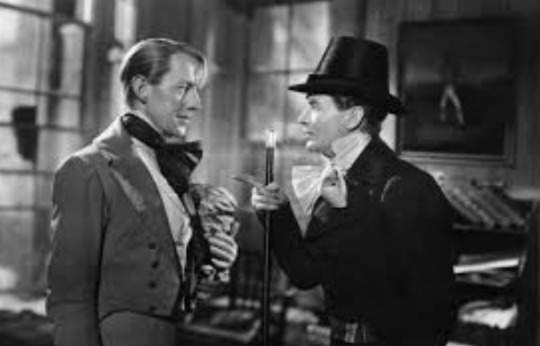
“A young gentleman of great expectations.”
Themes of wealth and ambition vs. affection and compassion. Inspiration for Thomas Hutter character, who seeks social advancement, wealth and climb the social ladder, motivated by a desire of self-improvement. Friedrich Harding is Thomas’s Pip Estella; as he wishes to emulate him, and become a sophisticated gentleman. The arrogance and snobbishness of the upper class. Taking damaging risks in order to achieve ambition (traveling to a remote and mysterious castle), and falling into debt to sustain a certain lifestyle (with Friedrich). Learning that love is more important than wealth, the hard way (both Friedrich and Thomas).
5. “The Queen of Spades” (1949)

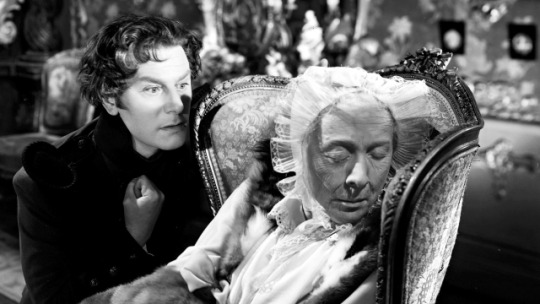
“If you've any human feeling in your breast, you can't refuse me. I beg. I beseech you. I know why you won't speak. The secret is connected with some terrible sin. That's it, isn't it? I'll make a bargain with you; tell me your secret and I'll take your sin upon my soul. Do you hear me? I mean it. A bargain. I'll take your sin upon my own soul.”
Theme of the horror element relying on Gothic ambience and atmosphere, than overt terror. Heavily rely on visual symbols to give meaning to the story: in “Nosferatu” are the lilacs and windows showcasing the connection between Ellen and Orlok. The idea that malevolent forces are at work is introduced early in the narrative. Theme of Faustian deals with the Devil. Themes of fate and the supernatural commanding the life of the characters, and leading to their demise. Themes of greed, power and pride leading to ruin; thirst for power as a pathway to madness, loss of dignity and loss of compassion for others, embodied in Herr Knock’s character, as he won’t stop at nothing to learn Orlok’s secret of immortality.
6. “The Innocents” (1961)


Miss Giddens: Were Quint and Miss Jessel in love? They were in love, weren't they? Mrs. Grose: Love? [Laugh] Oh, I suppose that's what she called it. But it was more like a sickness. A fever that leaves the body burned out and dry.
Themes of sexual repression and Victorian views of female sexuality (wickedness; sickness, shame; contagion; corruption) vs. love (pure; virginal; sacred; innocent; over-protective). The female protagonist overbearing protection of the children/Thomas masks her underlying conflict with her own sexuality (which she sees as sinful, shameful and diseased). Probably the inspiration for connecting flora (lilacs vs. willow tree) with the Ellen and Orlok, too.
7. “Andriesh” (1954)


Theme of the folk horror fairy tale, which also characterizes “Nosferatu”. The inspiration for Thomas dwelling in Transylvania and traveling to Castle Orlok, in the Carpathian Mountains; as he’s also given a magical token for protection, meets the people targeted by the supernatural, and faces a perilous journey to reach the castle, and then escape the castle; making allies along the way (Romanian old lady and the Nuns).
8. “Vechir na Ivana Kupala” (“The Eve of Ivan Kupalo”) (1968)


Theme of a darkly evocative, poetic and imagistic story deeply rooted in folklore. Use of several and overlapping cinematic techniques (fast motion, camera angles, etc.), to break the sense of reality within the film; in “Nosferatu” this probably translates in the dream/nightmarish atmosphere and hallucinations. Quick changes in tone (from horror to comedy to melodrama). Non-linear story and “show, not tell” approach; where the symbolism, mythology and cinematic complexity are more important than dialogue. Probably also the inspiration for Orlok giving Thomas’s a mount of gold as payment for his signature on the covenant, which will lead to the ruin of his marriage to Ellen.
9. “Leptirica” (“The She-Butterfly”) (1973)


Theme of a story and a vampire heavily influenced by folklore; in “Nosferatu”, by Romanian (strigoi). Use of humor to disarm the viewer. Withholding the reveal of the vampire to the audience; starting with close-ups on the hands, eyes, etc. Using a horse to find the grave of a vampire (in Balkan folklore it’s a black stallion, but Eggers probably choose white to be more visible in the night). A new and completely original ending to a cult classic. The female lead character appears to be naïve and harmless, but is revealed to be the true monster of the film.
#Nosferatu 2024#Robert Eggers#Ellen Hutter 2024#Count Orlok 2024#Thomas Hutter 2024#Friedrich Harding#Herr Knock 2024#lily rose depp#bill skarsgård#nicholas hoult#aaron taylor johnson#wuthering heights#catherine x heathcliff#Svengali#Svengali 1931#la belle et la bête#beauty and the beast 1946#the innocents#the innocents 1961#great expectations#great expectations 1946#the queen of spades#andriesh 1954#the eve of ivan kupalo#vechir na Ivana kupala#leptirica#the she butterfly
231 notes
·
View notes
Text




















The Eve of Ivan Kupalo (1968) dir.Yurii Illienko
#The Eve of Ivan Kupalo#absolutely outstanding movie#better than most world classics#but not so popular because while empires were pouring a lot of money into art#Ukrainian cinema was trying to somehow survive in the soviet totalitarian machine#this post cost me 85 hryvnias#Evening on the eve of Ivan Kupala#Vechir na Ivana Kupala#Yurii Illienko#ukrainian art#ukrainian cinema#ukraine#cinemetography
11 notes
·
View notes
Photo










Vechir na Ivana Kupala, Yuri Ilyenko, 1968
30 notes
·
View notes
Text
Conjuring Nosferatu: Robert Eggers shares the eight films that inspired his remake of “Nosferatu” (2024)
“It’s a world of Gothic Romance, fairy tales, and folklore, made by filmmakers with a passion to transport the audience to another time, another place, and another way of thinking and believing.” Robert Eggers reveals the list of other films (besides 1922 “Nosferatu”) that influenced his version of “Nosferatu” at Lincoln Center
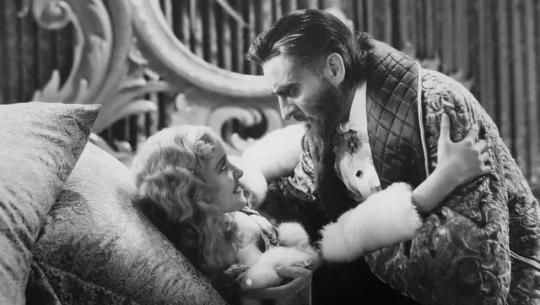
Archie Mayo | Svengali | 1931 (USA)
A dark and seductive tale of obsession and manipulation. A talented young singer falls under the spell of the sinister musician Svengali. As Svengali's influence over the singer grows, he begins to control every aspect of her life, leading to a dramatic and terrifying climax.
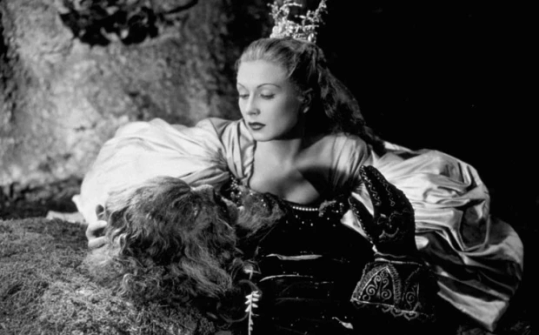
Jean Cocteau | La Belle et la Bête (Beauty and the Beast) | 1946 (France)
Belle’s father is sentenced to death for picking a rose from Beast’s garden. Belle offers to go back to the Beast in her father’s place. Beast falls in love with her and tests her by letting her return home but telling her that if she doesn’t return to him within a week, he will die of grief.
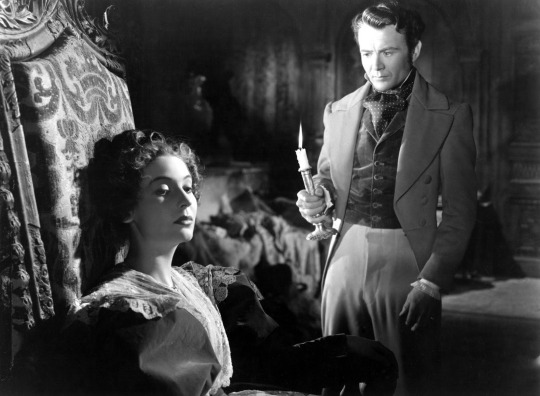
David Lean | Great Expectations | 1946 (UK)
Orphan Pip discovers through lawyer Mr. Jaggers that a mysterious benefactor wishes to ensure that he becomes a gentleman. Reunited with his childhood patron, Miss Havisham, and his first love, the beautiful but emotionally cold Estella, he discovers that the elderly spinster has gone mad from having been left at the altar as a young woman, and has made her charge into a warped, unfeeling heartbreaker.

Thorold Dickinson | The Queen of Spades | 1949 (UK)
Countess Ranevskaya, an elderly woman sold her soul to the Devil in order to always win at cards. Captain Herman Suvorin, an embittered Russian soldier, becomes obsessed with discovering her secret and also finds himself smitten by her beautiful young companion, Lizaveta Ivanova. As Suvorin gets closer to the truth, his quest takes an unforgettably eerie turn.
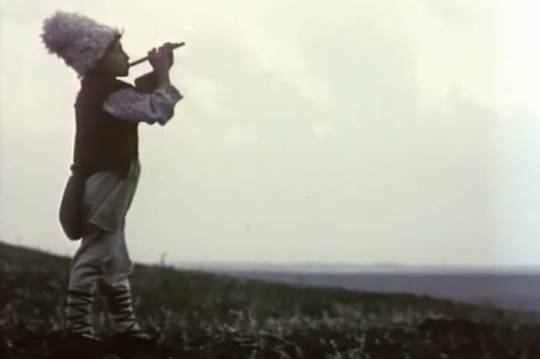
Yakov Bazelyan and Sergei Parajanov | Andriesh | 1954 (Soviet Union)
The evil sorcerer Black Whirlwind kidnaps the flock of a young shepherd boy, Andriesh, along with his beloved talking sheep, Miora, and his loyal dog, Lupar. Heartbroken, Andriesh embarks on a journey to rescue them. He receives a magical flute as a gift from the warrior Vainovan, which is meant to guide him to the castle of Black Whirlwind, who despises all living things.

Jack Clayton | The Innocents | 1961 (USA; UK)
In Victorian England, the uncle of orphaned niece Flora and nephew Miles hires Miss Giddens as governess to raise the children at his estate with total independence and authority. Soon after her arrival, Miss Giddens comes to believe that the spirits of the former governess Miss Jessel and valet Peter Quint are possessing the children. Miss Giddens decides to help the children to face and exorcise the spirits.

Yuri Ilyenko | Vechir na Ivana Kupala (The Eve of Ivan Kupalo) | 1968 (Soviet Union)
Petro is a modest farmhand living in an impoverished village in some unspecified long-ago era. He wants to marry the lovely Pidorka, but her stern father won’t hear of it. The mischievous demon Basavriuk, offers a deal, enticing Petro into crime for the sake of fortune. Based on Nikolai Gogol’s short story “The Eve of Ivan Kupala” (“St John’s Eve”) and Ukrainian folk tales.
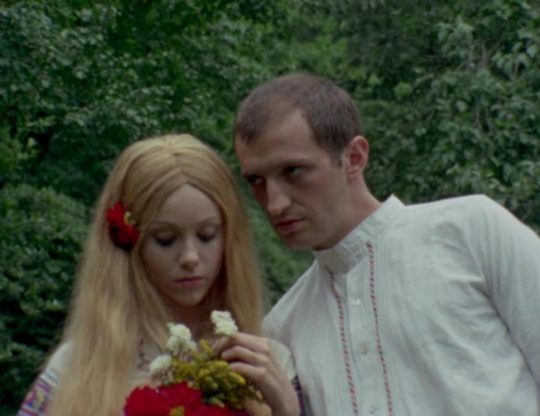
Djordje Kadijevic | Leptirica (The She-Butterfly) | 1973 (Yugoslavia)
Based on a revered classic of Serbian nineteenth-century literature, the short story “After Ninety Years” by Milovan Glisic. Its hero is Strahinya, a poor lad in rural Serbia who falls in love with the local landowner's daughter: in order to prove himself worthy of her love, he has to spend a night in an accursed mill. It is said that a vampire is sucking the blood of unfortunate mill men, thereby bringing the village to the verge of famine
#nosferatu 2024#robert eggers#Svengali#La Belle et la Bête#Jean Cocteau#Great Expectations#The Queen of Spades#Andriesh#The Innocents#The Eve of Ivan Kupalo#Leptirica#The She-Butterfly
110 notes
·
View notes
Text
With the knowledge of all the themes and inspirations of Robert Eggers for his adaptation of “Nosferatu” (2024), a few things are clearer.
This film isn’t only “Gothic horror”, it’s also Folk Horror, because that’s Robert Eggers “thing”. It’s also a dark fairy tale (“demon lover story”); the first song of the OST is even called “Once Upon a Time”. It’s a love letter to Eastern European cinema, too. It’s a story based on Romanian folklore, Transylvanian and Western European History, influenced by European cinema. Years on the making, alongside a team of academics and researchers.
1) Intricate, non-linear and highly symbolic storytelling
This story relies a lot on visual devices to create the narrative, inspired by “Queen of Spades” (1949) and “Vechir na Ivana Kupala” (“The Eve of Ivan Kupalo”) (1968). These are more important than dialogue, because there are many unreliable narrators in this film. Ellen and Orlok love story is represented by the lilacs (inspired by “The Innocents” (1961), where the willow tree was connected to the ghost couple) and windows (strigoi folklore and “Wuthering Heighgs” inspiration).
Orlok true nature is revealed on his iconography: sigil and coat of arms; he’s a Pagan worshipper of ancient Dacian god Zalmoxis; but was demonized as a “devil worshipper” by Christianity (as every Pagan religion in Europe was). He was deemed unworthy of entering Zalmoxis kingdom, but was only cursed to become a strigoi when Ellen awoke him, at the beginning of the film (he had been dead for centuries). Why? Related to his backstory. In Romanian folklore, strigoi haunt their loved ones, they want to relive their life together. Which indicates Ellen is possibly a reincarnation of the woman Orlok loved in life, which explains the covenant of them being together in spiritual world forever, and the “Svengali” (1931) inspiration.
2) Who is the true villain of this film?
At first glance, it’s Orlok. If we look deeper into the inspiration of “Leptirica” (“The She-Butterfly”) (1973) and strigoi folklore, it’s Ellen; she’s the one who unleashes Orlok. She also has a premonition Thomas will be sent away and looks at the window (Orlok). Then, she cuts a strand of her hair and puts it on a locket and it appears it’s meant to Thomas, but the visual subtext tells a different story: she knows Thomas will be sent to Orlok, and her strand of hair smells of lilacs; a scent Orlok later recognizes, and uses the locket to have access to her again. We also see Ellen at the beach, on the shore, while communicating with him. Later, Orlok arrives at Wisburg. She opens the window for him to access the Harding household, and then to her own house, on the “third night”. Ellen is the one who gives Orlok access to places (rooted in strigoi folklore, the “vampires need to be invited in” lore); she’s the one who calls for him throughout the film, which is why Lily-Rose Depp said she’s the one calling the shots in the film.
But, Ellen is described as the only heroic character by Robert Eggers, so she can’t be the real villain of the film. Nevertheless, she’s seen as a “monster” by society, as well; her supernatural gifts are medicalized as “hysteria”, and she needs to be contained with drugs and restraining devices (corsets; tied to the bed). When she’s communicating with Orlok in what Victorian doctors call “epilepsies”, she’s knocked unconscious with drugs, she’s tied to the bed, and her corset is tightened, increasing more control over her (literally and metaphorically), attempting to break her trance mediumship (her nature, her sexuality).
The true villain of the story is Christian Victorian society; with its norms, expectations and doctors; “Wuthering Heights” and “Great Expectations” (1949) inspiration. The society that medicalizes the protagonist, and labels her “mad”, “child” and “a creature” (like Von Franz calls her). The same Christianity that demonizes Orlok, is the same which demonizes Ellen. The “modern world” (19th century) has no place for them, they both belong to Pagan times.
3) Love vs. Sex
Now, we have to talk about love. What is love in this film? It’s the Victorian ideal presented in “The Innocents” (1961) dichotomy: love is Christian, pure, sacred, virginal, innocent, overprotective vs. sex, which is wickedness, sickness, shameful; contagious; corruptive, and, yes, demonic. It’s the occult meaning, too. And these two things (love and sex) are deemed as opposites in Victorian society, specially when women are concerned (because women don’t know nor have nor can aspire to have/know sexual pleasure). And this “love” is also connected to “heart”, which is another theme in this film; Ellen connects her heart to Thomas and Anna.
Anna and Thomas love Ellen. How is this love shown? By dismissing her concerns as “fancies” and pretending they don’t exist (consequence of her medicalization), and by calling the doctors to deal with her. Like Robert Eggers said; they don’t and can’t understand Ellen, and are dismissive of her. The “Great Expectations” (1946) inspiration is seen in Thomas desire to become like his wealthy friend, Friedrich Harding, as he aspires to climb the social ladder and be a gentleman, which means, symbolically, to transform Ellen into Anna, a perfect Victorian lady, which means to be an ideal/model of purity, chastity, sophistication and modesty. The opposite of what Ellen wants, as we see her being consumed by her corset until she tries to be break free of it during her scene with Thomas, to make him understand. But he doesn’t, because he can’t, he’s too wrapped up in social convention, and so his reaction is to call for the doctor to handle her. And she promises she’ll be good, she’ll contain her nature, like Friedrich Harding told her earlier, she’ll “find the dignity to display the respect for [her] caretaker” aka her husband, she’ll be a good and decent Victorian wife. Because women were supposed to be submissive to their husbands; to the husband that owns them. And so Thomas exerts his dominance and possession over Ellen when she tells him he could never please her like Orlok. Friedrich rapes his dead wife corpse; the ultimate symbol of women as ownership of their husbands in the Victorian era.
It soon becomes clear this “love” is connected to Ellen’s medicalization and to Victorian society itself. Ellen’s love of Thomas is overbearing protection and melodrama, also influenced by the protagonist of “The Innocents” (1961) love for the children she was hired as governess. But this “love” is also paranoid and suffocating, leading to tragedy. She clings on to Thomas not to escape Orlok (because she keeps inviting him in), but to escape herself, her own darkness and to contain her sexuality within the social accepting frame of marriage.
And so, no, Orlok cannot love… like this. Because he’s the opposite of medicalization and Victorian society; he’s the Pagan sorcerer, he’s sex, and he’s death. As a consequence he’s everything Victorian society deems female sexuality to be: wickedness, sickness, shameful, and corruptive, a infectious plague upon the world. Because sobrenatural creatures are always archetypes and metaphors in Gothic horror.
4) Breaking the Curse
At the surface, Orlok is a strigoi doing strigoi things; or a beastly Heathcliff taking revenge on Catherine/Ellen because she chose Edgar/Thomas instead of him. Symbolically, he’s taking revenge on the society that medicalizes and ostracizes Ellen; as he kills every archetype of “Victorian idealized role model” in the narrative, namely the Hardings. Like “Leptirica” (“The She-Butterfly”) (1973), “Nosferatu” (2024) has a folklore vampire, whose real appearance is slowly revealed to the audience.
But that’s not all that Orlok is; like the Bête (Beast) in “La Belle et la Bête” (“Beauty and the Beast”) (1946), he’s a cursed creature, and his curse is being a strigoi, a vampyr, a Nosferatu. A curse Ellen created when she awoke him with her summoning prayer. And a curse for which Orlok knows the “cure”, because the answer is in the Şolomonari codex of secrets (which Von Franz finds on Herr Knock’s office):
“And so the maiden fair did offer up her love unto the beast, and with him lay in close embrace until first cockcrow, her willing sacrifice thus broke the curse and freed them from the plague of Nosferatu.”
Here the “La Belle et la Bête” (“Beauty and the Beast”) (1946) inspiration is obvious: Orlok is a cursed beast whose curse can only be broken by a woman’s love. And that’s what he wants, and what he seeks. Like Bête with Belle, Orlok also gives Ellen a countdown to accept him or else someone is dying. And like “La Belle et la Bête”, Ellen only accepts Orlok when the men are conspiring to have him killed. And she says to Von Franz she has to be the one to stop Orlok, even though the professor never shared what he learned from the Şolomonari book with her, and only encourages her to be true to her nature.
She accepts Orlok’s covenant (“you shall be one with me ever-eternally”), fully aware of everything it implies, because it has to be a willing sacrifice from her part. And the threat of his destruction convinced her, because her soul isn’t the only thing Ellen is giving to Orlok during their “wicked wedding”; she’s giving him her heart, metaphorically and literally, as he’ll feed of her heart’s blood. And they both know they will die, because death is a requirement of their covenant (“you are not for the living”). Inspired by “Wuthering Heights” and “Svengali” (1931); Ellen and Orlok could never be together in life, are united in death, and reunited in the spiritual world, forever. And Von Franz confirms to the audience: Ellen’s love broke Orlok’s curse and freed them (both) from Nosferatu, as he places their lilacs around their embraced bodies. And that’s the love story at the end.
Robert Eggers went with the “Leptirica” (“The She-Butterfly”) (1973) inspiration here: a new and completely original ending to a cult classic. Because Eggers wanted the “vengeance” he talked about when discussing the ending. The vindication of sexualized female characters in Gothic literature, especially in “Dracula” by Bram Stoker. Ellen, the sexualized character who embraced the monster (herself/Orlok/sexuality) is the one who saves the day, but she also dies in the physical realm because Victorian society believes she deserves to be punished by her sin.
#Nosferatu 2024#Robert Eggers#Ellen Hutter 2024#Count Orlok 2024#Friedrich Harding#Anna Harding#Nosferatu 2024 analysis#Thomas Hutter 2024
64 notes
·
View notes
Text
I haven’t talk about this until now because I’m actively ignoring these “interpretations” about “Nosferatu” (2024), but when these are the most popular here (and everywhere, apparently), and the most “liked” and “reblogged” post is how “people not comprehending this film correctly” followed by the most incorrect statement of all time, Von Franz is also compelling me to speak in the name of angels and demons with his Abraxas stone ring (if you don’t know what a “Abraxas stone ring” is, you shouldn’t even be attempting to interpret and analyze this film to begin with).
First: it’s mindblowing to me how folks are trying to interpret this story while systematically ignoring (either by choice or ignorance, I don’t even know at this point) all the inspirations and themes in it; yes, this story is based on “Dracula” by Bram Stoker, and “Nosferatu: A Symphony of Horror” (1922), but Robert Eggers also shared he was inspired by “Wuthering Heights” by Emily Brontë, and cinematic inspirations: “Svengali” (1931), “La Belle et la Bête” (Beauty and the Beast) (1946), “Great Expectations” (1946), “The Queen of Spades” (1949), “The Innocents” (1961), “Andriesh” (1954), “Vechir na Ivana Kupala” (“The Eve of Ivan Kupalo”) (1968) and “Leptirica” (“The She-Butterfly”) (1973).
Second, more than “Gothic horror” (Female Gothic genre, to be more specific), this film is Folk Horror because that’s Robert Eggers brand. This is a story is based on Romanian folklore: strigoi, Şolomonari and Zalmoxis worship. Orlok is a strigoi doing strigoi stuff, he’s also a Pagan who worshipped Zalmoxis to conquer the secret of immortality, and like all Pagans, he was demonized as a “devil worshipper” by Christianity.
Third, attempting to interpret what’s happening on-screen without any knowledge of the Victorian era, it’s incorrect. Robert Eggers has no interest in doing “modern takes” in his work; he transports his audience to the time period where his films take place. This means, the dialogue, behavior and beliefs of his characters will reflect the historical time in question. If you are interpreting all of this with modern day bias, you are incorrect in your interpretations, simple as that. If you don’t understand the meaning of the words, browse a Old English dictionary (I have no problem admitting I did this, actually).
Last but not least: attempting to interpret this film without knowing the alchemist and occult meaning behind this story is also incorrect. Are you familiar with Aleister Crowley occult system Thelema? Because it was already a part of the OG 1922 “Nosferatu”, Eggers just took a different route to arrive at the same message (the birth of New Age of Aquarius), because he wanted the divine feminine goddess. Do you know who Paracelsus is? He’s the reason why Ellen is called a “sylph”. Who Babalon and her Beast are? That’s Ellen and Orlok in this story. Eggers went full “all hail Babalon” in this film, because Ellen is the hero of the story, but not in the way everyone thinks. Christians know Babalon by another name: “the whore of Babylon” from the “Book of Revelations”.
After you understand all of these themes and inspirations, it’s when you start “problematizing” this story, and taking your own conclusions of it, or making parallels with other stories, not before.
64 notes
·
View notes